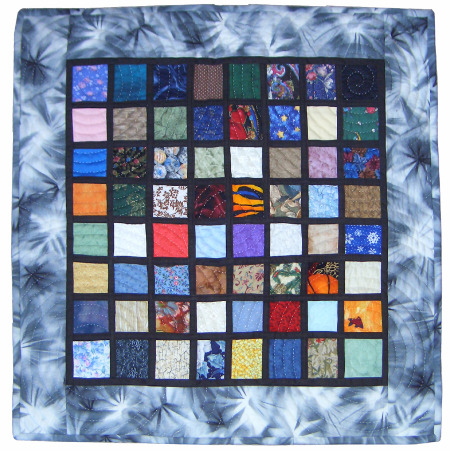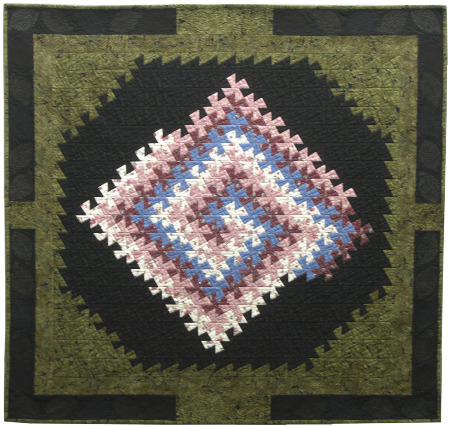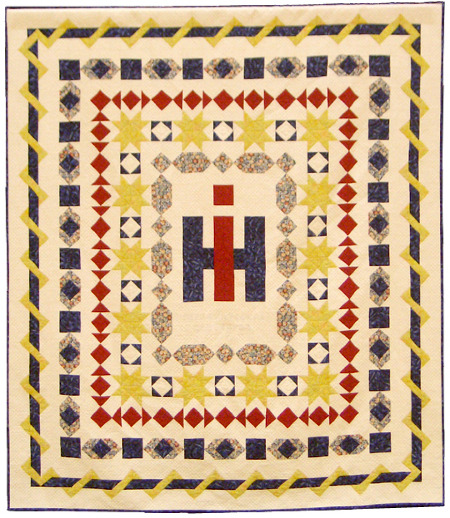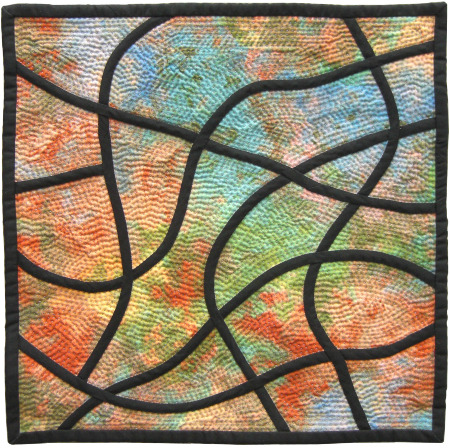By Carolyn Edlund
Quilter Jean Judd forged a career in fiber arts from the ground up. Self-taught and determined, she has been successful for over two decades and remains very busy with commissions and exhibitions.

Jean had no preconceptions about being a textile artist, and hasn’t felt constrained by any boundaries while pursuing her career. She spoke with me to about how she got started and how she continues to grow her business.
AS: You don’t have a background or education in the arts. How did you get started?
JJ: While my children were just beginning school in the late 1980s, I watched quite a few PBS shows about quilting. These were traditional quilt patterns and the rotary cutter had only been on the market for a short time. This cutter revolutionized quilt making as no longer did the maker have to draw out shapes and cut with scissors. Now the fabric pieces were much more accurate and quick to cut.
In 1990 I decided that I could easily make quilts similar to what was being shown on TV but with my own design and technique. I bought end pieces from a bargain bin, and began constructing quilts. The first two quilts were for my children and now my grandchildren have them on their beds.
The third quilt I pieced from the leftovers and it sold with no effort on my part to market it. This was my moment of realizing that my own designs were interesting to people and I could do what I loved and also satisfy others.

AS: A lot of the quilts you sell are commissioned. How do you market yourself and target clients?
JJ: Most of my early commissions were word of mouth promotion by satisfied clients and repeat business. Now juried exhibitions and my web presence brings in several commissions a year.
My first web presence in 2005 was setting up my own gallery on the Yessy gallery site. This was inexpensive and very simple to do myself since it was basically typing in a word processor type of program. I was the only textile artist on this fine art site, and requested to have a Textile Category. It was included within a couple of days. I didn’t have sales of artworks presented, but I did receive commissions so it was worthwhile for me. Glass artists, painters, and photographers are very successful on this site.
Yessy was a stepping stone to setting up my own art website in 2008. Using Yessy showed me how easy it was to maintain my own site. My current platform is not exactly the same, but it is now only my artwork, without thousands of other artworks competing for viewing time.
I maintain contact with my mailing list by doing a yearly postcard mailing. Clients, collectors and potential customers are so inundated with emails, that I find a better communication to be the standard postcard. It directs people to my web site to see what is happening. My mailing list includes interior designers, art consultants, gallery directors, collectors, etc. I send out about 300 to 400 postcards a month and within twelve months, I have gotten through my mailing list. Then I design a new postcard and start sending again. This keeps my addresses current for the most part and doesn’t swamp my list with mail, but reminds them to check out what is going on with my work every year.

AS: Your resume is filled with many exhibitions you have done. How many do you apply to? Which ones work best for you and why?
JJ: I apply to about 25 juried exhibitions a year. It is usually a mixture of fine art exhibitions, art quilt exhibitions, and quilt shows. I have a much higher success rate of being accepted into fine art shows the last few years so I am focusing more on them than the others. Personally, I find that I get more promotion for the buck by being in the fine art exhibits. They usually are 20 to 45 days or longer and the patrons of these exhibits, galleries, and museums are the people who commission and buy my artwork.
It is difficult to pigeonhole my work into a specific category. I do very little representative work, but I am able to apply under either Mixed Media or Fiber categories. I have rarely completed an artwork for a specific exhibit. I feel this limits its life for exhibit if it is too narrowly focused. I try to find exhibits that fit my work, not make my work fit their exhibit. My work retains the “quilt” aspect as it is not framed or mounted, but is easily displayed using gallery and museum hanging systems and a simple slat with eye screws or eye hooks. I hear continuous comments from viewers at shows that they really want to touch my artwork. That is the best compliment you can get in the textile artwork field in my book.

AS: Do you have any advice for emerging artists on finding a balance in your career, and aligning your work with your values?
JJ: As artists, we all want to spend every waking moment creating art, but in reality this is not possible. I have found that I have to spend about four or five hours a day on the business side of my art. This includes answering emails, developing ads for magazines, submitting for exhibitions, writing articles for magazines, updating my web site and other web presences, commenting on other artists’ blogs, preparing commission proposals, preparing monthly postcard mailings, preparing artwork for shipment to exhibits, updating my resume and portfolio, etc.
I call it a successful day if I have a five to six hour block of time in the studio working on art (whether that is a commission piece or a piece I plan on submitting for exhibition). Marketing takes a lot of time out of my day and it also takes time for it to show results; it is not an instantaneous process.
Keeping up on what is happening in all areas of the art world is a must. I subscribe to several magazines, most all having to do with the business of art or art itself for the most part, and some quilt related magazines so I can keep up with new innovations. This is also how I find exhibition opportunities, calls for public art commissions, artists to collaborate with, etc. I also have read 20 or 30 books on the business of art which helped in my pricing strategies, marketing, websites, etc.


As a fellow fiber artist (I work in Batik), of the magazines you listed above, which ones did you find were the most useful to you in terms of getting into shows and exhibitions? I find most of the craft minded ones were too much how to create, vs other ones like Art Calendar had some listings, but I got bored with the information they provided
Hi Muffy,
I do find many exhibition opportunities in the Art Calendar one, but more so from their weekly email with listings that don’t make it into the print magazine. I also think that joining the American Craft Council and getting the information from their magazine is a good place as well.
Another place to consider is signing up for the CAFE (Call for Entry) site https://www.callforentry.org/index.php
This site is for public art commissions, art sales, and some exhibitions as well. You really have to do the leg work to find some of them.
Once you have submitted to a few of the larger ones, they will put you on their mailing list and you’ll get a prospectus automatically for their yearly exhibits.
Nice article. Lovely work!
I am an artist and in Feb 2009 I created a blog to share info w/other artists, called the Artist Marketing Salon blog.
THis blog has grown tremendously receiving approx. 150 visitors per day, sometimes peaking to 300 hits in a day.
I am also seeking articles for my Artist Marketing Salon blog.
Have a look, here is the link: http://ArtistMarketingSalon.wordpress.com
Thanks for bringing your blog to my attention, Marie. I hadn’t heard of it before. I did go over and take a look briefly and found one museum I would be interested in submitting to. I’ll have to spend more time browsing later on. Another great resource for artists of all mediums.
Jean
I started the blog just to store and share some of my research w/other artists but it has expanded enormously and I receive increasing numbers of visitors, when the common wisdom is that you can create a blog but expect to receive few visitors. What it needs is a make-over by a great blog designer, but the info is solid. Best wishes to you
Jean,
You are a wealth of information, I’ve learned some valuable lessons from your interview. Thank you for sharing.
Jean, Thank you so much for this great interview. This is the most helpful article I have read about how to market yourself as a quilt artist in years. I find myself in the quilting magazines and sell some of my patterns in my online shop, but have not been successful enough to make a real living yet. I want to move on to the next level and stop being a “starving artist”! Have a super day!